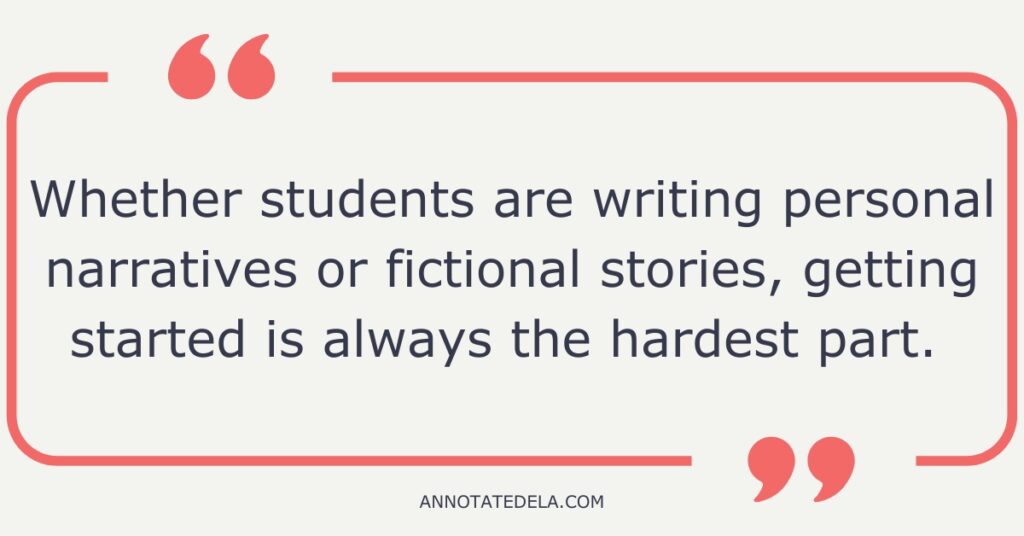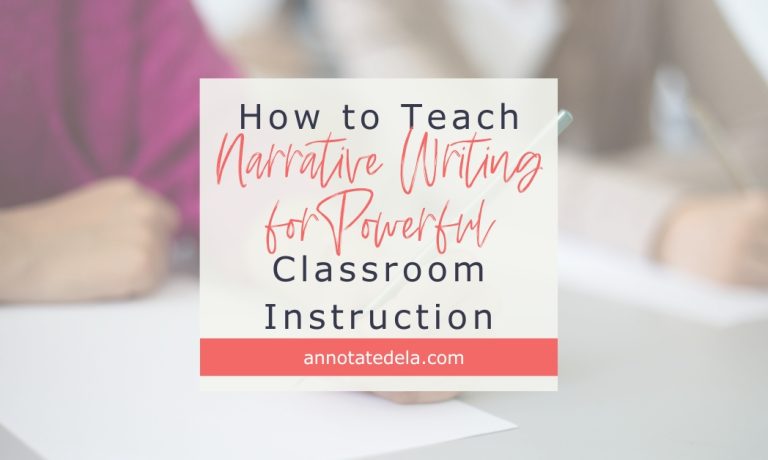How to Teach Narrative Writing for Powerful Classroom Instruction is a continuation of Narrative Writing: A Step-by-Step Guide for Success in Middle School. In that blog post, we explored the first three steps in a narrative writing unit. This post will explore steps four through six in a narrative writing unit.
This blog post and the series of blog posts that follow are designed as a comprehensive guide, crafted with the middle school classroom in mind.
Whether you are a seasoned educator seeking fresh ideas or a novice teacher eager to embark on this writing adventure, this guide will equip you with the tools to guide your students towards becoming proficient storytellers.
Download the Narrative Scope and Sequence for a detailed guide on how to guide students through the narrative writing adventure.

How to Teach Narrative Writing: Brainstorm
Whether students write personal narratives or fictional stories, getting started is always the hardest part. Prompts and sentence starters are ways to get students thinking; students can have a notebook to keep their writing and reference tools for the writer’s craft.
As students brainstorm, they can make lists of topics for narratives, share with peers, and meet with the teacher.
Use the brainstorming time to check in with students and have quick conferences or chats with students to get the status of the class. It’s a great time to help students struggling with a topic.
Students may also struggle because they think it has to be an epic topic or story – they might feel their ideas are not ‘good’ enough.
Remind them that small moments can have a significant impact on the reader.
Students need to have a topic that excites them. Not being into the topic will make the entire writing process a struggle.
It may also be beneficial to have students revisit quickwrites or other completed writing activities before brainstorming. Intentionally brainstorming before starting writing is another way to prepare students for developing topics.
Finally, if you have required prompts and are not seeing the engagement and motivation from your students, consider developing a new prompt – even have students help. Choice and voice will motivate students.
How to Teach Narrative Writing: Have a Plan – Map Out the Story
Now that students have ideas, it’s time to map it out. Mapping out or drafting an outline ensures that there is a story to tell. It can also be a guide or a reference as students write the story.
Remind students that they do not have to have the whole story figured out at this point.
The planning is an outline of the general plot points and big ideas.
When students plan, have them outline the conflict, sequence of major events, climax, and resolution. Students should have a beginning, middle, and end. Students can draw and write as they map out the story.
It’s also a chance for students to consider the characters, and setting.

How to Teach Narrative Writing: Fast Draft
Now that students have brainstormed and planned, it’s time to write the first draft. This can be a struggle; even with all of the planning, students might still feel like they must have it all figured out before writing.
Many students also think that the first draft is the final draft. If you know, you know. The process of writing is hard work and takes more than one draft, but as writers, we hide all that work with one final draft.
Getting students out of this one-and-done mindset can be difficult, but instead of calling it a first draft, try calling it a fast draft.
Have students write the fast draft as quickly as they can while still touching upon all major elements of their story map. This can be messy, and details may be missing. This is okay!
This is about progressing through the process, having a starting point, and not having it all figured out.
After students have written the fast draft, it will be time to start the writing workshop – join me next week as we explore the final three stages of a narrative unit.
Looking for more ideas on how to teach narrative writing? Check out the previous blog post, Narrative Writing: A Step-by-Step Guide for Success in Middle School, in this series of blogs on how to teach narrative writing for the first three steps in a narrative writing unit.




One Response